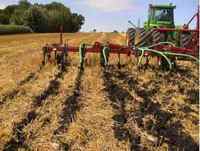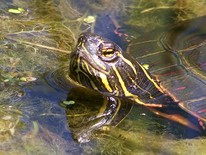 USDA Regional Conservation Partnership Program
Applications are due by May 10 for $260 million in Regional Conservation Partnership Program grants from the US Department of Agriculture aimed at improving water quality and combatting drought.
Proposals sought for water quality, outreach and conservation finance. Agriculture Secretary Tom Vilsack today announced the availability of up to $20 million in competitive grants through the Conservation Innovation Grants (CIG) program. The program aims to spark the development and adoption of cutting-edge conservation technologies and approaches for farmers, ranchers and other landowners. Contact: Kaveh Sadeghzadeh 202-720-2182

Farmers find success with variable rate P applications
“We have been able to sign up growers for our VRT program that wouldn’t consider it in the past. Some have even paid for additional acres out of their own pockets.” – ag retailer cost-share participant
Low crop prices have farmers focused on ways to minimize costs while optimizing inputs. For many, variable rate phosphorus application makes sense for optimizing this input, but the costs to get involved can prevent many from taking the leap. The Partnership for Ag Resource Management (PARM) is helping ag retailers and growers overcome this barrier through a new cost share pilot using Variable Rate Technology (VRT) in the Sandusky River Basin, Ohio with funding from the National Fish and Wildlife Foundation.
Kewaunee-Door county farmers create watershed imitative
Thirty-five farmers in Northeastern Wisconsin have formed an environmental stewardship coalition. Members of the new group operate farms ranging in size from 66 cows to 6,000 cows. The goal of the organization, called Peninsula Pride Farms, is "to leverage the ingenuity of the agricultural community, university research and scientists to meet water quality challenges."
A great article about efforts in the Rock River basin.
Learn about the latest activities and efforts from farmers participating in the UW Extension Discovery Farms program.
New Land and Water Resource Management Requirements
To receive annual DATCP grant funds, counties have historically been required to have a current work plan on file with the department. The LWCB, at its February 2 meeting, agreed that efforts should be made to improve annual work planning conducted by counties and to evaluate the results of the new approach. For more information, review this memo and visit DATCP's LWRM website.
Jenny Vanderlin discusses Heart of the Farm, a University
of Wisconsin-Extension program committed to addressing the needs of farm women
by providing education on farm business topics, connecting them with
agricultural resources and creating support networks.
|

The DNR Surface Water Monitoring Program strategy provides for three levels of monitoring in rivers and streams; Baseline, Prescribed, and Local Needs. These, along with the full monitoring program are described in Wisconsin's Water Monitoring Strategy: 2015-2020. For this year, Koshkonong Creek will be the focus of a Targeted Watershed Assessment (TWA) under the Prescribed Needs strategy.
Koshkonong Creek
This summer we will be conducting our Target Watershed
Assessment (TWA) on the Koshkonong Creek Watershed. This will include 5 HUC12 in Dane and
Jefferson Counties. We will take a
comprehensive look at the biological communtities. Biological monitoring will include: Fish
Index of Biotic Integrity sampling (FIBI), Macroinvertebrate sampling to
include Hilsenhoff Biotic Integrity (HBI) and Macroinvertebrate Index of Biotic
Integrity (MIBI), and Diatom Nutrient Index (DNI) sampling.
The number of surveys will include: 22 fish stations , 15 macroinvertebrate
stations and 8 diatom stations. Surveys
will begin in May and will be completed by October.
|

Water Pollutions and Solutions
A new documentary sponsored by WI Land and Water highlights all aspects of watershed and water quality restoration, including a highlight of the farmer-led initiative in the Red Cedar Watershed:
http://intotheoutdoors.org/segments/water-pollutions-solutions/
A community of people passionate about water education,
outreach, and research in Wisconsin will be on hand for the launch of the new
Wisconsin Water Thinkers Network this month.
|

New Storm Water Guidance Open
for Public Comment
The proposed guidance addresses
how to account for internally drained areas in an MS4 TMDL modeling analysis.
Access via: http://dnr.wi.gov/news/input/Guidance.html#open
WinSLAMM Course Opportunity
Learn how WinSLAMM software can help you calculate stormwater runoff volume, pollution loads, and assess a wide range of management measures. Modeling stormwater impacts in new or existing systems, this Windows-based program will help you choose the most effective control measures, and give you the data needed to select the most cost-effective stormwater control practices.
|

Steve Anderson, a water resources analyst with Clean Water Services (Hillsboro, Ore.), wrote and recorded a lighthearted song called “Don’t Flush the Baby (Wipes!)” The song conveys the importance of not flushing baby wipes, cleaning pads, and paper towels.
|
April 1: DATCP Producer Led Watershed Protection Project Grants
April 15: Nutrient Management Farmer Education Grant
April 15: WI DNR Urban Nonpoint Source & Storm Water Management Grants
May 1: DNR Knowles Nelson Stewardship Program Urban Rivers Grants
May 10: USDA Commits $20 Million
to Innovative Conservation Projects
May 10: Regional Conservation Partnership Program Grants
|